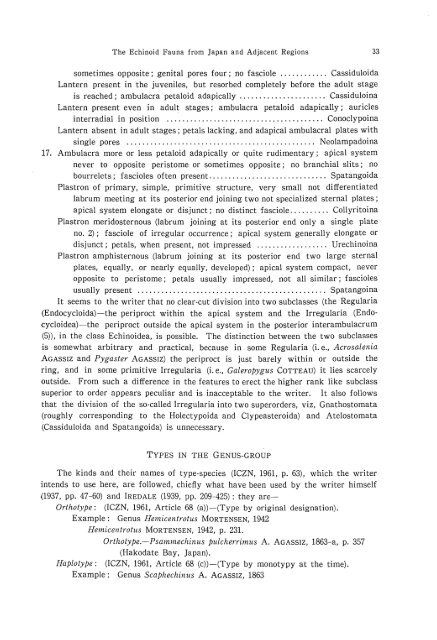the echinoid fauna from japan and adjacent regions part i
the echinoid fauna from japan and adjacent regions part i
the echinoid fauna from japan and adjacent regions part i
You also want an ePaper? Increase the reach of your titles
YUMPU automatically turns print PDFs into web optimized ePapers that Google loves.
The Echinoid Fauna <strong>from</strong> Japan <strong>and</strong> Adjacent Regions 33<br />
sometimes opposite; genital pores four; no fasciole ............ Cassiduloida<br />
Lantern present in <strong>the</strong> juveniles, but resorbed completely before <strong>the</strong> adult stage<br />
is reached; ambulacra petaloid adapically ...................... Cassiduloina<br />
Lantern present even in adult stages; ambulacra petaloid adapically; auricles<br />
interradial in position ........................................ Conoclypoina<br />
Lantern absent in adult stages; petals lacking, <strong>and</strong> adapical ambulacral plates with<br />
single pores ................................................ Neolampadoina<br />
17. Ambulacra more or less petaloid adapically or quite rudimentary; apical system<br />
never to opposite peristome or sometimes opposite; no branchial slits; no<br />
bourrelets; fascioles often present.................... . . . . . . . . .. Spatangoida<br />
Plastron of primary, simple, primitive structure, very small not differentiated<br />
labrum meeting at its posterior end joining two not specialized sternal plates;<br />
apical system elongate or disjunct; no distinct fasciole .......... Collyritoina<br />
Plastron meridosternous (labrum joining at its posterior end only a single plate<br />
no. 2); fasciole of irregular occurrence; apical system generally elongate or<br />
disjunct; petals, when present, not impressed .................. Urechinoina<br />
Plastron amphisternous (labrum joining at its posterior end two large sternal<br />
plates, equally, or nearly equally, developed); apical system compact, never<br />
opposite to peristome; petals usually impressed, not all similar; fascioles<br />
usually present ................................................ Spatangoina<br />
It seems to <strong>the</strong> writer that no clear-cut division into two subclasses (<strong>the</strong> Regularia<br />
(Endocycloida)-<strong>the</strong> periproct within <strong>the</strong> apical system <strong>and</strong> <strong>the</strong> Irregularia (Endocycloidea)-<strong>the</strong><br />
periproct outside <strong>the</strong> apical system in <strong>the</strong> posterior interambulacrum<br />
(5)), in <strong>the</strong> class Echinoidea, is possible. The distinction between <strong>the</strong> two subclasses<br />
is somewhat arbitrary <strong>and</strong> practical, because in some Regularia (i. e., Acrosalenia<br />
AGASSIZ <strong>and</strong> Pygaster AGASSIZ) <strong>the</strong> periproct is just barely within or outside <strong>the</strong><br />
ring, <strong>and</strong> in some primitive Irregularia (i. e., Galeropygus COTTEAU) it lies scarcely<br />
outside. From such a difference in <strong>the</strong> features to erect <strong>the</strong> higher rank like subclass<br />
superior to order appears peculiar <strong>and</strong> is inacceptable to <strong>the</strong> writer. It also follows<br />
that <strong>the</strong> division of <strong>the</strong> so-called Irregularia into two superorders, viz, Gnathostomata<br />
(roughly corresponding to <strong>the</strong> Holectypoida <strong>and</strong> Clypeasteroida) <strong>and</strong> Atelostomata<br />
(Cassiduloida <strong>and</strong> Spatangoida) is unnecessary.<br />
TYPES IN THE GENUS-GROUP<br />
The kinds <strong>and</strong> <strong>the</strong>ir names of type-species (ICZN, 1961, p. 63), which <strong>the</strong> writer<br />
intends to use here, are followed, chiefly what have been used by <strong>the</strong> writer himself<br />
(1937, pp. 47-60) <strong>and</strong> IREDALE (1939, pp. 209-425) : <strong>the</strong>y are-<br />
Orthotype: (ICZN, 1961, Article 68 (a))-(Type by original designation).<br />
Example: Genus Hemicentrotus MORTENSEN, 1942<br />
Hemicentrotus MORTENSEN, 1942, p. 23l.<br />
Orthotype.-Psammechinus pulcherrimus A. AGASSIZ, 1863-a, p. 357<br />
(Hakodate Bay, Japan).<br />
Haplotype: (ICZN, 1961, Article 68 (c))-(Type by monotypy at <strong>the</strong> time).<br />
Example: Genus Scaphechinus A. AGASSIZ, 1863












